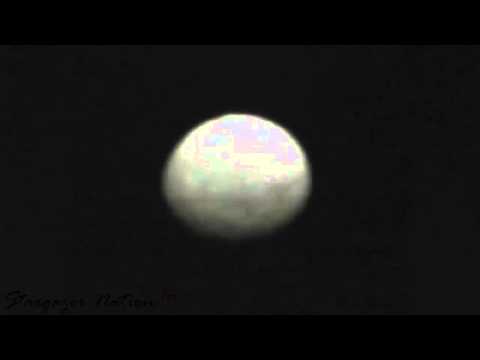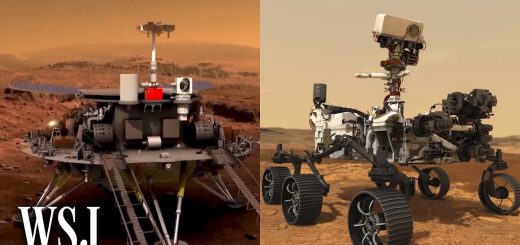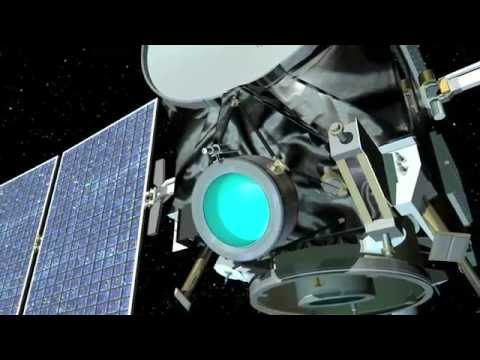China’s Zhurong vs. NASA’s Perseverance: Rover Tech in Mars Space Race | WSJ
– This isNASA’s Perseverance rover. And this is China’s Zhurong Rover,named after the Chinese god of fire. And these two vehiclesare on a mission to explore Mars. – The US and China are clearlyin a political competition here on Earth,so it should not be surprisingthat it has now also becomepart of the space aspect. – Roger, three seconds. – The US is the global leaderwith more than 50 years of Mars research. – About 20 meters off the surface. – And last February,Perseverance was NASA’sfifth rover to land there. China is the newcomer with a Mars programthat started in 2006. But the country has big plansfor its first mission, called Tianwen-1. – The fact that Tianwen-1is an orbiter landerand rover all in oneis a very gutsy move for a first mission. – This ambition makesthe Zhurong rover differentfrom NASA’s Perseverance. So here’s what these two vehiclesare carrying and what they can tell usabout the new space racebetween both superpowers. Since this is China’s first attemptto touch down on Mars,a major goal is to make sure its roveractually lands in one piece. And it’s expected tohappen some time in May. – Landing on Mars is very difficult. – JonathanMcDowell is an astrophysicistat the Harvard-SmithsonianCenter for Astrophysics. And he’s been studying space programsaround the world for over 40 years. – It’s harder than landingon Earth from spacebecause the atmosphere is thinner,so parachutes don’t work as well. And it’s harder than landing on the moon. You can’t just use the rocket engines. – So the Chinese landerthat will release the Zhurong roverhas an intermediate solution,using parachutes and rocket thrustersto slow down for a softer landing. – You wanna go somewhere thatyou maximize your chancesof a successful missionbecause there’s already so many thingsthat can go wrong. – So China haschosen a relatively easy placefor touchdown, a basin inthe northern hemisphere,known as Utopia Planitia. It’s where NASA landedits second Mars lander,the Viking 2, in 1976. – It doesn’t have a lot of big mountainsor big canyons or cliffsthat the rover might fall offand so it’s a good firstplace to try and explore. – Since thisis old terrain for NASA,Perseverance landed in a different area,called the Jezero Crater. – So Perseverance has landedat the edge of an old river delta. So you have this landscape,which is a mixture of cratersand mountains that aregentle, rolling hills. – It’s a tougherlanding area comparedwith Utopia Planitia. But Perseverance is equippedwith a more advanced landingsystem called Skycrane. – About to conductthe Skycrane maneuver. – So it helpedthe rover hover above groundwhile a computer visionsystem scanned for obstacles. These two different types of terrainsmean both countrieshave packed their roverswith different scientific goals in mind. And one of China’s main focusesis getting familiar with the new planet. – It has a pretty standardset of instrumentsthat will help Chinesescientists understandwhat it’s like to operate at Mars. – China is bringing better techto Utopia Planitia thanwhen NASA did decades ago. – The technology on the Zhurong roveris probably similar towhat was on the Spiritand Opportunity rovers thatNASA flew a few years ago. And it’s still fairly modern tech. – So this isZhurong’s multi-spectral camera,which can take pictures indifferent colored filtersto study various rocks on Mars’ surface. There’s also a penetrating radarthat emits radio wavesand when pointed at the surface,the rover can pick up signalsand collect data about what’s underneath,particularly water ice. Like Zhurong, Perseveranceis also surveying Marsbut it’s larger in size. So NASA has equipped it with more tools,like a helicopter called Ingenuitythat could one day help explore the planeton a bigger scale. – It’s the first objectto make a controlled flightin the atmosphere of another planet,which is quite an engineering challenge. – One of the main goalsis to learn about life on the red planetand scientists say the best wayto do this is bringingback samples to Earth. So Perseverance has a robotic armthat can drill into the surface,extract rocks or collect loose soil. The samples are then put in clean tubesto prevent contamination. And then these are stored here,inside the rover’s tummy. NASA plans to bring back the samplesto Earth by 2031 in a joint missionwith the European Space Agency. – Even though, in some respects,the US space technology isstill the most advanced,the missions that China’s executingare actually very impressive now. So they’ve been catching up very quickly. – China’s space programhas enjoyed supportfrom the absolute top leadershipsince the very beginning,dating back to Mao Zedong. – Dean Chengis a research fellowat the Washington-based think tank,the Heritage Foundation. And he’s been watchingChina’s space programfor more than 20 years. He says the country’s political systemis an advantage when it comesto planning ambitiousprojects, like going to Mars. – Xi Jinping and theChinese Communist Partydoesn’t face regular elections. So China is able to makelonger-term decisionsand as important, sustain those decisions. – And those decisionsare financially sustained. So while there’s little public informationabout China’s space budget,Cheng says it’s likely not a small amount. – China doesn’t provide those numbersbut what we do know is, for example,China has four space launch facilities. That’s more than any other country. – China’s state-funded programmakes it fundamentally differentto how NASA works. – So the US, for example,has talked about going back to the moonfor at least 20 years. But with each Congressand with each president,priorities change,funding therefore changes. – For instance,NASA’s annual budgethasn’t hit its peak from the 1960s,fluctuating more or less over the years. And in contrast to China,NASA is an open civilian agency. It has shared its technologyand fostered a commercial space industry. – And liftoff. – Which has taken over manyof NASA’s launch tasks andhelped with space exploration. So if the Zhurong landsand operates on Mars,that means China will have done moreand faster in less time than the US. This success wouldn’t just be a pointof national pridebut would also get the country closerto accomplishing other space goals,including building a moon baseand its own International Space Station. – China is presentingitself as an alternative. With regards to the moon and Mars,most of that is for political signaling,political demonstrations to show the worldwho has a more capable technological baseand a better political system.













